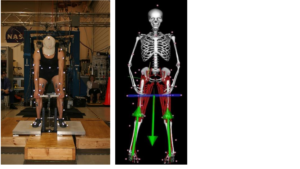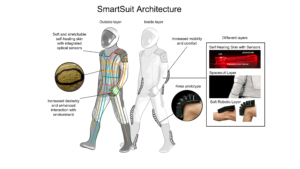The musculoskeletal system might experience importent detriments in extreme environments. We use modeling approaches and computational tools to investigate human biomechanics and musculoskeletal performance in challenging environments, such as human-spacesuit interactions and musculoskeletal performance to novel exercise devices.
Human Spacesuit Interaction – Extravehicular Activity (EVA) is a highly demanding activity during space missions. The current NASA spacesuit, the Extravehicular Mobility Unit (EMU), might be thought of as the ‘world’s smallest spacecraf’ and is quite an engineering achievement. However, the EMU has also led to discomfort and musculoskeletal injuries, mainly due to the lack of mobility in the pressurized suit that makes moving and operating within the suit challenging. We are developing a new musculoskeletal modeling framework in OpenSim to analyze human-spacesuit interaction and musculoskeletal performance during EVA.

Exercise using the HULK Device – Astronauts experience physiological deconditioning in space due to the extended exposure to microgravity including, but not limited to, muscle atrophy, loss of strength, and bone loss. Current countermeasures on the International Space Station include resistance training as well as aerobic exercises, and the use of the Advance Resistive Exercise Device (ARED) has been effective in reducing spaceflight musculoskeletal deconditioning. However, the ARED is a bulky device and compact devices that minimize mass and volume are necessary for use within the new space exploration vehicles. In collaboration with NASA Ames, we are investigating exercise performance on the Hybrid Ultimate Lifting Kit (HULK), a new lighter and more compact exercise device under development.


